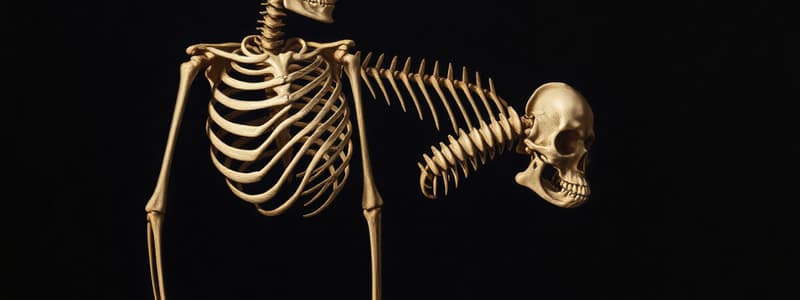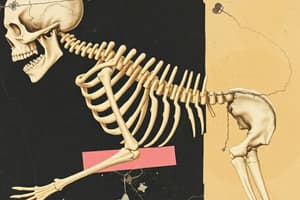Podcast
Questions and Answers
What is the primary function of the skeletal system?
What is the primary function of the skeletal system?
- Stores minerals and vitamins
- Regulate body temperature
- Support and protect body structures (correct)
- Produce energy for the body
Which type of cartilage is the most flexible?
Which type of cartilage is the most flexible?
- Elastic cartilage (correct)
- Cartilaginous cartilage
- Fibrocartilage
- Hyaline cartilage
What is the role of the perichondrium in cartilage?
What is the role of the perichondrium in cartilage?
- It is composed of cartilage cells
- It provides nutrients and resists expansion (correct)
- It produces synovial fluid
- It forms the cartilage matrix
Which type of cartilage is least flexible and has great tensile strength?
Which type of cartilage is least flexible and has great tensile strength?
Which type of cartilage is known for being the most abundant?
Which type of cartilage is known for being the most abundant?
What type of tissue primarily composes skeletal cartilage?
What type of tissue primarily composes skeletal cartilage?
What structure forms the framework around cartilage?
What structure forms the framework around cartilage?
Which function of bones supports soft organs in the body?
Which function of bones supports soft organs in the body?
What is the primary structural unit of compact bone?
What is the primary structural unit of compact bone?
Which component of bone is responsible for its hardness and resistance to compression?
Which component of bone is responsible for its hardness and resistance to compression?
During which developmental stage does the formation of the bony skeleton begin?
During which developmental stage does the formation of the bony skeleton begin?
Which type of cells are involved in bone remodeling and repair?
Which type of cells are involved in bone remodeling and repair?
What happens to the epiphyseal plate when all cartilage is ossified?
What happens to the epiphyseal plate when all cartilage is ossified?
Where is red marrow primarily found in adults?
Where is red marrow primarily found in adults?
How does bone strength in resisting tension compare to steel according to the content?
How does bone strength in resisting tension compare to steel according to the content?
Which type of marking is characterized by a hole that allows vessels or nerves to pass through?
Which type of marking is characterized by a hole that allows vessels or nerves to pass through?
Which zones are part of the epiphyseal plate involved in bone growth?
Which zones are part of the epiphyseal plate involved in bone growth?
What occurs to yellow marrow under conditions of anemia?
What occurs to yellow marrow under conditions of anemia?
Which projection is defined as a round prominence at the end of a bone?
Which projection is defined as a round prominence at the end of a bone?
What percent of bone mass is made up by inorganic components?
What percent of bone mass is made up by inorganic components?
In which areas of the skeleton is hematopoiesis most active in adults?
In which areas of the skeleton is hematopoiesis most active in adults?
Which type of bone marking refers to a cavity or hollow space within the bone?
Which type of bone marking refers to a cavity or hollow space within the bone?
What does the term 'epicondyle' refer to?
What does the term 'epicondyle' refer to?
What is the purpose of bone markings on external surfaces?
What is the purpose of bone markings on external surfaces?
What percentage of bone mass is recycled each week?
What percentage of bone mass is recycled each week?
How often is spongy bone replaced?
How often is spongy bone replaced?
Which hormone stimulates osteoclast activity in response to low blood calcium levels?
Which hormone stimulates osteoclast activity in response to low blood calcium levels?
What is the role of calcitonin in the body?
What is the role of calcitonin in the body?
What is the primary function of calcium in the body?
What is the primary function of calcium in the body?
Which factors regulate bone remodeling?
Which factors regulate bone remodeling?
What triggers the secretion of parathyroid hormone (PTH)?
What triggers the secretion of parathyroid hormone (PTH)?
What is required for the intestinal absorption of calcium?
What is required for the intestinal absorption of calcium?
Which fracture type is characterized by the bone being broken but the skin remaining intact?
Which fracture type is characterized by the bone being broken but the skin remaining intact?
What is the primary process that occurs immediately following a bone fracture?
What is the primary process that occurs immediately following a bone fracture?
In which type of fracture does one side bend while the other is broken, typically seen in children?
In which type of fracture does one side bend while the other is broken, typically seen in children?
Which of the following correctly describes a comminuted fracture?
Which of the following correctly describes a comminuted fracture?
What happens during the soft callus formation after a fracture?
What happens during the soft callus formation after a fracture?
What characterizes a greenstick fracture?
What characterizes a greenstick fracture?
Which type of fracture is often associated with twisting injuries, such as those from skiing?
Which type of fracture is often associated with twisting injuries, such as those from skiing?
Which systemic sign indicates inflammation following a fracture?
Which systemic sign indicates inflammation following a fracture?
Flashcards are hidden until you start studying
Study Notes
The Skeletal System
- The skeletal system provides support and protection for the body's structures.
- It acts as a framework, composed of bones, joints, and supporting connective tissues.
- Muscles work with bones to produce movement at the joints.
Skeletal Cartilage
- Skeletal cartilage is made of highly resilient, molded cartilage tissue, primarily composed of water.
- Contains no blood vessels or nerves.
- Surrounded by a layer of dense connective tissue called the perichondrium, which provides support and contains blood vessels for nutrient delivery.
- Cartilage cells, known as chondrocytes, are housed in small cavities called lacunae within the extracellular matrix.
Types of Cartilage
- Hyaline Cartilage: The most abundant type, providing support, flexibility, and resilience. Contains only collagen fibers. Found in articular joints, ribs, respiratory structures, and the nose tip.
- Elastic Cartilage: Similar to hyaline cartilage but contains elastic fibers, making it the most flexible type. Found in the external ear and epiglottis.
- Fibrocartilage: Contains thick collagen fibers, providing great tensile strength and the least flexibility. Found in the menisci of the knee and vertebral discs.
Bone Markings
- Projections: Indicate sites of muscle, ligament, and tendon attachment, or areas involved in joint formation. Examples include head, process, condyle, epicondyle, and crest.
- Depressions or Holes: Serve as conduits for blood vessels and nerves. Examples include foramen, fissure, sinus, fossa, and meatus (canal).
Compact Bone
- Consists of:
- Osteon (Haversian system): Basic functional unit of compact bone, containing lamellae, a central canal, and canaliculi.
- Canals and canaliculi: Channels that house blood vessels and nerves.
- Interstitial and circumferential lamellae: Layers of bone matrix surrounding osteons.
- Perforating (Volkmann’s) canals: Run perpendicular to central canals, connecting the blood vessels and nerves of the periosteum, medullary cavity, and central canal.
Bone Composition
- Organic Components:
- Osteoblasts, osteoclasts, and osteocytes - cells responsible for bone formation, resorption, and maintenance.
- Collagen fibers - contribute to bone's tensile strength and flexibility.
- Inorganic Components:
- Hydroxyapatites (mineral salts): Make up 65% of bone by mass.
- Primarily consist of calcium phosphate crystals, responsible for bone's hardness and resistance to compression.
Ossification (Osteogenesis): Bone Formation
- The process of bone tissue formation.
- Begins in month 2 of embryonic development.
- Postnatal bone growth continues until early adulthood.
- Bone remodeling and repair occur throughout life.
- New cartilage grows at epiphyseal plates, where ossification replaces cartilage with bone.
- When all cartilage is ossified, bone growth ceases, leaving an epiphyseal line.
Bone Remodeling
- Bone mass is constantly recycled, with spongy bone replaced every 3-4 years and compact bone every 10 years.
- Involves both bone deposit and bone resorption.
- Remodeling units, containing osteoblasts and osteoclasts, coordinate the process at periosteal and endosteal surfaces.
- Osteoclast activation is influenced by parathyroid hormone (PTH) and immune T cell proteins.
Calcium Homeostasis
- Bone acts as a reservoir for calcium, which plays crucial roles in nerve transmission, muscle contraction, blood coagulation, and other essential processes.
- Parathyroid hormone(PTH): Released in response to low blood calcium levels, stimulates osteoclasts to resorb bone, releasing calcium into the bloodstream.
- Calcitonin: Released from the thyroid gland in response to high blood calcium levels.
Types of Bone Fractures
- Closed fracture: A simple fracture with no open wound.
- Open fracture: A broken bone protrudes through the skin or an external wound leads to a broken bone.
- Greenstick fracture: One side of the bone is broken while the other is bent, common in children.
- Impacted fracture: The broken ends of the bone are jammed into each other.
- Comminuted fracture: Multiple fracture lines with splintering or crushing of the bone.
- Spiral fracture: The bone is twisted apart, common in skiing accidents.
- Transverse fracture: The fracture goes straight across the bone.
- Oblique fracture: The break occurs at an angle across the bone.
Fracture Repair
- A series of steps involving:
- Blood clot formation.
- Blood vessels grow into the clot, bringing connective tissue.
- Fibroblasts and chondroblasts convert the clot into a soft callus.
- Macrophages clear debris, while osteoclasts resorb dead bone tissue.
- Osteoblasts transform the soft callus into a hard callus of spongy bone.
- Osteoclasts and osteoblasts remodel the hard callus into compact bone.
Studying That Suits You
Use AI to generate personalized quizzes and flashcards to suit your learning preferences.




